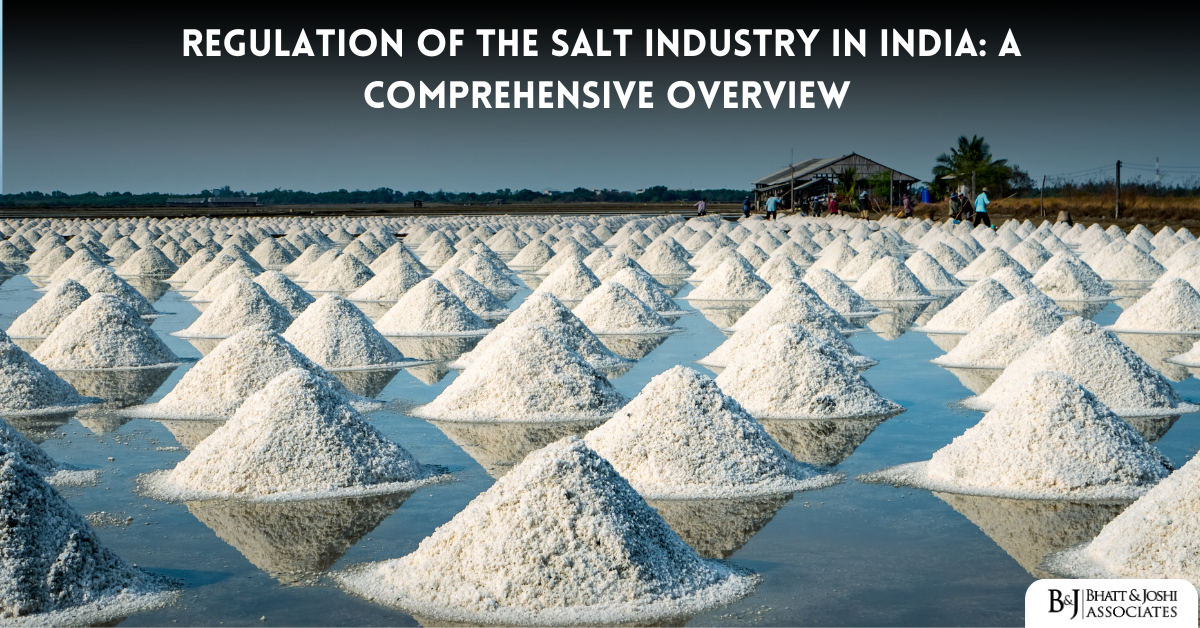Introduction
Salt, a commodity of immense importance both for human consumption and industrial use, has played a significant role in India’s history and continues to be a vital sector of the country’s economy. The salt industry in India is unique in its structure and regulation, reflecting the commodity’s strategic importance and its role in public health. This document provides an in-depth exploration of the regulatory framework, laws, and significant case laws governing the salt industry in India, with a particular focus on the Salt Commissioner’s Organization.
Regulatory Body: Salt Commissioner’s Organization
The primary regulatory authority for the salt industry in India is the Salt Commissioner’s Organization, operating under the Department of Industrial Policy and Promotion, Ministry of Commerce and Industry, Government of India. Established in 1961, this organization is responsible for the overall development of the salt industry, ensuring adequate production and supply of salt, and implementing various schemes for the welfare of salt workers.
The Salt Commissioner’s Organization has a rich historical background, tracing its roots to the British era when salt was a state monopoly. Post-independence, the organization’s role has evolved from being a revenue-collecting body to a facilitator and regulator of the salt industry. Today, it plays a crucial role in monitoring salt production, quality control, and the implementation of government policies related to the salt sector.
Legal Framework Governing Salt Industry in India
The legal framework governing the salt industry in India is multifaceted, reflecting the commodity’s importance in various spheres, from public health to industrial applications.
Salt Cess Act, 1953
This Act forms the cornerstone of salt industry regulation in India. It provides for the levy and collection of a cess on salt. Section 3 of the Act states:
“There shall be levied and collected in such manner as may be prescribed a cess on all salt manufactured in India at such rate not exceeding fourteen paise per forty kilograms as the Central Government may, by notification in the Official Gazette, from time to time specify.”
The proceeds of this cess are used for salt workers’ welfare and the development of the salt industry. The Act also empowers the Central Government to make rules for carrying out the purposes of the Act, including the manner of collection of the cess and the utilization of the proceeds.
Prevention of Food Adulteration Act, 1954 (replaced by Food Safety and Standards Act, 2006)
While not specific to salt, this Act has significant implications for the salt industry, particularly in relation to iodized salt. The Act, and its successor, the Food Safety and Standards Act, 2006, lay down standards for food items, including salt. Section 23 of the Food Safety and Standards Act, 2006, states:
“No person shall manufacture, distribute, sell or import any novel food, genetically modified articles of food, irradiated food, organic foods, foods for special dietary uses, functional foods, nutraceuticals, health supplements, proprietary foods and such other articles of food which the Central Government may notify in this behalf.”
This provision has been crucial in regulating the production and sale of iodized salt, which is mandatory in many parts of India as a public health measure to prevent iodine deficiency disorders.
Mines and Minerals (Development and Regulation) Act, 1957
This Act is relevant to the salt industry as it governs the mining of rock salt. While most salt in India is produced through solar evaporation of sea water, rock salt mining is also a significant source. The Act provides for the regulation of mines and the development of minerals. Section 13 of the Act states:
“No person shall undertake any reconnaissance, prospecting or mining operation in any area, except under and in accordance with the terms and conditions of a reconnaissance permit or of a prospecting licence or, as the case may be, of a mining lease, granted under this Act and the rules made thereunder.”
This provision ensures that rock salt mining is carried out in a regulated manner, with due consideration for environmental and safety aspects.
Key Case Laws Shaping Salt Industry in India
Several significant court judgments have shaped the interpretation and implementation of regulations affecting the salt industry in India.
Binani Industries Ltd. v. Union of India (2016)
This case dealt with the issue of levy of excise duty on salt. The Supreme Court of India held:
“Salt, being a basic necessity, has been exempt from excise duty. However, this exemption does not extend to all forms of salt or all stages of salt production. Value-added salt products or salt intended for industrial use may be subject to excise duty, depending on the specific circumstances and the degree of processing involved.”
This judgment clarified the tax implications for different categories of salt products, providing guidance for both the industry and tax authorities.
Centre for Public Interest Litigation v. Union of India (2000)
This landmark case dealt with the implementation of universal salt iodization in India. The Supreme Court observed:
“The mandatory iodization of salt is a crucial public health measure aimed at preventing iodine deficiency disorders. The government’s policy in this regard is based on sound scientific evidence and is in the interest of public health. However, the implementation of this policy must be carried out in a manner that does not unduly burden small salt producers.”
This judgment upheld the government’s policy on salt iodization while also emphasizing the need to consider the interests of small-scale salt producers.
Narmada Bachao Andolan v. State of Gujarat (2006)
While not directly related to salt production, this case had significant implications for the Little Rann of Kutch, a major salt-producing area in Gujarat. The Supreme Court, while dealing with environmental concerns, noted:
“The unique ecosystem of the Little Rann of Kutch, which supports both wildlife and traditional livelihoods including salt production, requires a balanced approach to development and conservation. Any regulatory measures or development activities in this region must take into account the environmental impact as well as the socio-economic needs of the local communities, including salt workers.”
This judgment highlighted the need for environmental considerations in salt production, particularly in ecologically sensitive areas.
Recent Developments and Initiatives
The regulatory landscape of the salt industry continues to evolve, with several recent initiatives aimed at addressing contemporary challenges and opportunities.
The Salt Commissioner’s Organization has been implementing the Scheme for Quality Control and Research in Salt Industry. This scheme aims to improve the quality of salt produced in India, promote research and development in salt production techniques, and enhance the overall competitiveness of the Indian salt industry.
The organization has also been focusing on the welfare of salt workers through various initiatives. The Salt Workers Welfare Scheme provides for health care, education, housing, and other social security measures for salt workers and their families. This scheme reflects the government’s commitment to improving the living and working conditions of those engaged in salt production.
In recent years, there has been an increased emphasis on modernizing salt production techniques. The Salt Commissioner’s Organization has been promoting the adoption of mechanized salt farming methods, which can significantly increase productivity and improve the quality of salt produced. This initiative includes providing technical guidance and financial assistance to salt producers for adopting modern technologies.
The government has also been working on enhancing the export potential of Indian salt. The Salt Commissioner’s Organization, in collaboration with other government agencies, has been promoting Indian salt in international markets, particularly focusing on value-added salt products.
Challenges and Future Outlook for Salt Industry in India
Despite its strategic importance and the supportive regulatory framework, the salt industry in India faces several challenges. Climate change and its impact on weather patterns pose a significant threat to solar salt production, which is highly dependent on predictable weather conditions. The industry also faces challenges in terms of land availability for salt production, particularly in coastal areas where there is increasing pressure for alternative land use.
The small-scale and unorganized nature of a significant portion of salt production in India presents challenges in terms of quality control and implementation of welfare measures for salt workers. There is a need for more comprehensive strategies to bring these small producers into the formal sector while ensuring their economic viability.
Environmental concerns, particularly in ecologically sensitive salt-producing areas like the Little Rann of Kutch, necessitate a delicate balance between salt production and conservation efforts. Future regulatory efforts may need to focus more explicitly on sustainable salt production practices.
Looking ahead, the regulatory framework for the salt industry is likely to evolve in response to these challenges. There may be a greater emphasis on promoting sustainable and eco-friendly salt production methods. This could include regulations and incentives for adopting water-saving technologies in salt production and measures to reduce the environmental impact of salt mining.
The issue of iodization is likely to remain a key area of focus. While universal salt iodization has been largely successful in India, there may be a need for more nuanced policies that balance public health needs with consumer choice and the interests of different segments of the salt industry.
As the industrial applications of salt continue to grow, particularly in the chemical industry, future regulations may need to address the specific requirements and challenges of producing high-purity industrial salt. This could involve new quality standards and certification processes for industrial-grade salt.
Conclusion: Balancing Regulation and Growth in India’s Salt Industry
The regulatory framework governing India’s salt industry reflects the commodity’s unique position at the intersection of public health, industrial policy, and traditional livelihoods. From the Salt Cess Act to recent initiatives for modernizing salt production, the legal and policy landscape demonstrates an evolving approach to managing this vital sector.
As India continues to navigate the challenges of climate change, public health imperatives, and industrial development, the regulatory approach to the salt industry will likely need further refinement. The key lies in striking a balance between ensuring adequate salt production, maintaining quality standards, protecting the interests of salt workers, and addressing environmental concerns.
The future of salt industry regulation in India will depend on the effective implementation of existing laws, continuous dialogue between stakeholders, and a willingness to adapt policies to address emerging challenges. By fostering an environment that encourages innovation, promotes sustainable practices, and safeguards the interests of all stakeholders, India can ensure that its salt industry continues to meet the nation’s needs while contributing to economic growth and public health.














